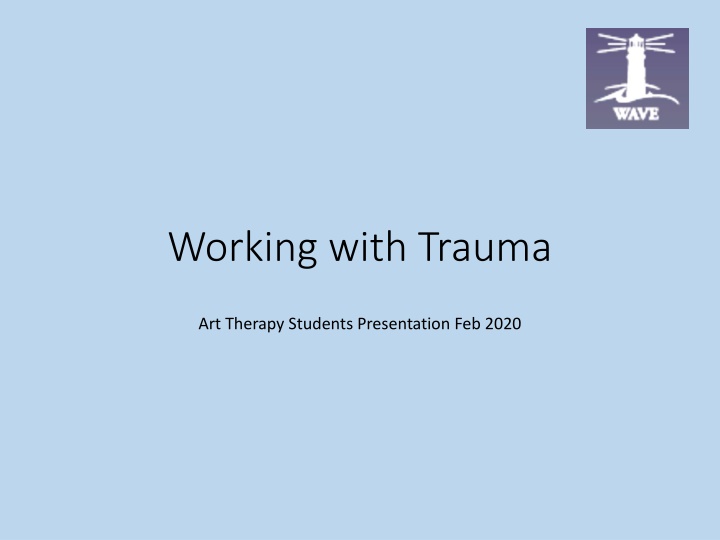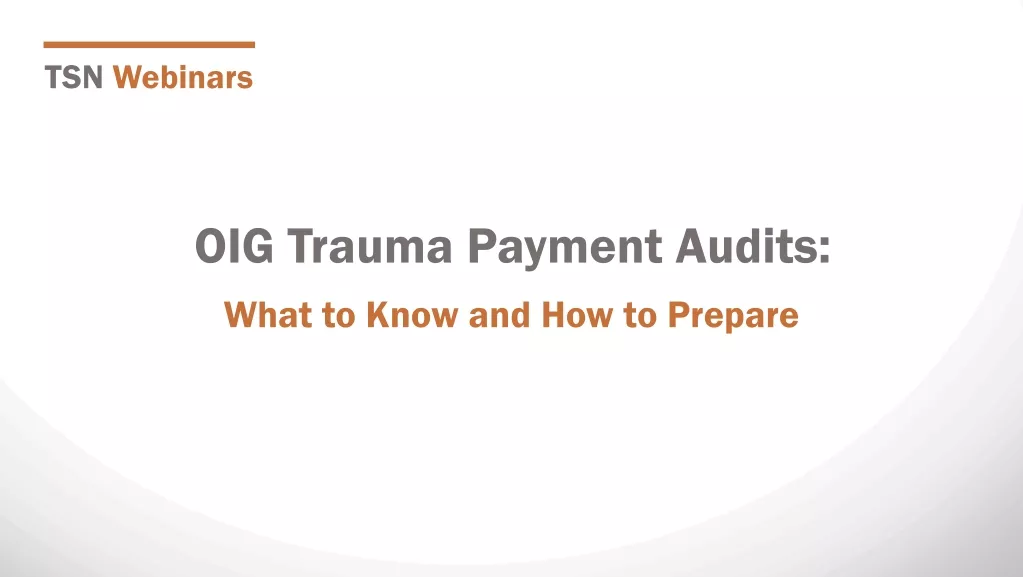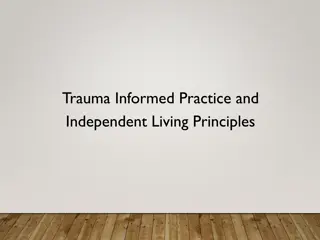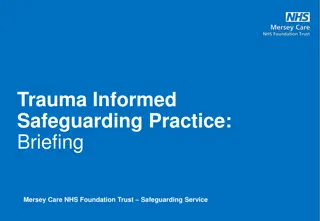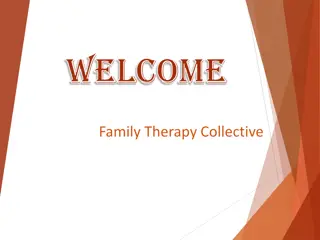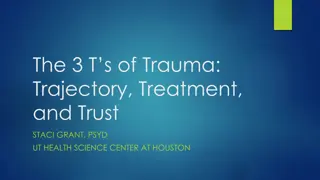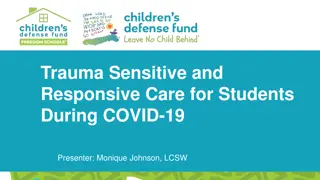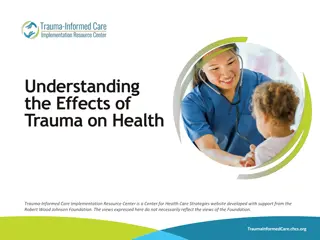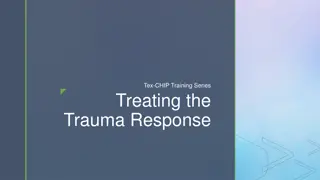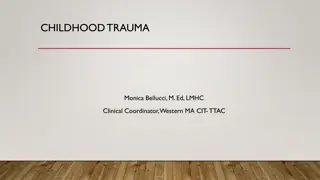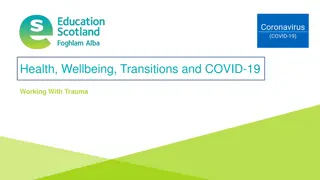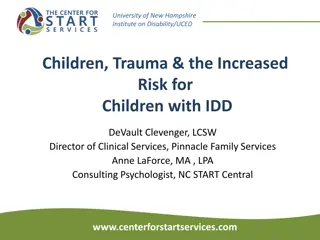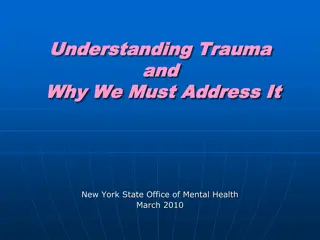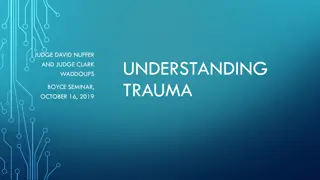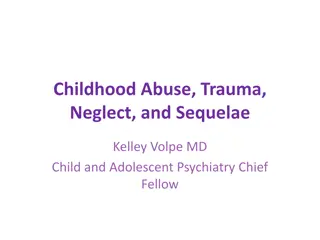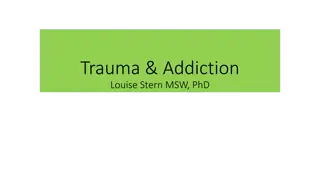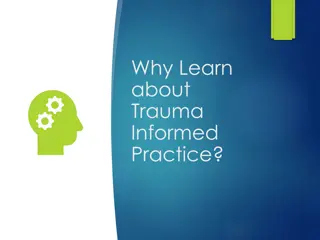Art Therapy Approaches for Trauma Presentation
Northern Ireland has a complex history of political conflict leading to widespread trauma. Explore the impact, key stages of development, and services offered by WAVE Trauma Centre to support individuals affected by the Troubles. Learn about the demographics, referral statistics, and various support programs provided by WAVE to address the needs of those impacted by trauma in the region.
Download Presentation

Please find below an Image/Link to download the presentation.
The content on the website is provided AS IS for your information and personal use only. It may not be sold, licensed, or shared on other websites without obtaining consent from the author.If you encounter any issues during the download, it is possible that the publisher has removed the file from their server.
You are allowed to download the files provided on this website for personal or commercial use, subject to the condition that they are used lawfully. All files are the property of their respective owners.
The content on the website is provided AS IS for your information and personal use only. It may not be sold, licensed, or shared on other websites without obtaining consent from the author.
E N D
Presentation Transcript
Working with Trauma Art Therapy Students Presentation Feb 2020
The Northern Ireland Context 1.8 m people 40+ years of political conflict Over 3,800 people have died Tens of thousands physically and psychologically traumatised
Impact of the Troubles A differentiated impact Historical unevenness (1971-76) Gender (90% men) Age (younger people) Geography (Belfast, Derry- Londonderry, South Armagh, mid-Ulster) Class (working class areas)
Key Stages of development 1991: WAVE was known as Widows Against Violence Empower- nucleus of 8 women brought together by Marie McNeice Constituted to provide services to innocent victims of sectarian murder 1993: changed to include all those bereaved regardless of religious, political, cultural views or circumstances 1995: changed again to include those injured- physically and psychologically. The acronym no longer stands- WAVE now registered as WAVE Trauma Centre.
WAVE offers: An extensive service from permanent Outreach Centres in Belfast, Armagh, Ballymoney, Omagh and Derry Londonderry- 15 satellite projects An eclectic model of service delivery to meet individual need. Counselling/ Psychotherapy Trauma Education Welfare/ Advice Outreach- Work Creative Storytelling Initiatives Complementary Therapies Advocacy Support Service Peer Group Support
WAVE April 2018-March2019 648 new referrals received in last year Age range of referrals was from four to eighty four years of age Average client age was 47 years of age. 57% male and 43% female. The referral breakdown for 2018-2019 is significant as referrals from males have outnumbered female for the second year in a row, last year being the first in the organisation s history
Equating to: 1370 casework visits from outreach staff, a 4.9% increase on last year. 653 individuals in counselling, a 16% increase on the previous year In complementary therapies we have 739 individuals receiving treatment. 344 individuals working with our Health and Wellbeing staff The welfare team have recouped 2million based on lump payments, backdated benefits and awards and appeals. 122 clients working with our advocacy team on historical enquiries and current cases. 51 peer group activities e.g. regional groups, mens groups, womens groups, injured group, choir, Survivors, Citizen Educators, Silent Testimony, knitting group.
Why learn about the Troubles? 22 years on from the Good Friday/Belfast Agreement, what has changed for Victims and Survivors on the ground? Talking about the Troubles in mixed company and in public is usually a taboo in NI and is sometimes confused with having to know about history or politics or being political. Learning about the Troubles in relation to your discipline, how it impacts people that you will be working with is neither historical or political, it is current, relevant, appropriate and best practice.
Stumbling Blocks In the past statutory services have not been accessible or responsive to victims Lack of knowledge on the long-term effects of the Troubles on the population. Become more informed on the debates within the field of psychological trauma. A gap in the training needs of professionals working with traumatised individuals. Lack of awareness and publicity about existing services, particularly in the voluntary and community sectors, which may not be well- funded
Working with Psychological Trauma Judith Herman introduces her book Trauma and Recovery (1992) with: The ordinary response to atrocities is to banish them from consciousness. Certain violations of the social compact are too terrible to utter aloud: this is the meaning of the word unspeakable. * We turn the TV off = we turn off. Remembering and telling the truth about terrible events are prerequisites both for the restoration of the social order and for the healing of individual victims.* They aren t the TV = they cant turn off. The conflict between the will to deny horrible events and the will to proclaim them aloud is the central dialectic of psychological trauma. *
So what is psychological trauma? A traumatic incident is where a person experiences, witnesses, hears about a (real or perceived) threat to the physical and or psychological integrity of self or others; whereby the persons response involves great fear, horror and or helplessness. Bessel Van Der Kolk (in Van der Kolk & Fisler 1995) defines psychological trauma as: an inescapably stressful event that overwhelms peoples existing coping mechanism
From Psychological Trauma to PTSD (adapted from Carolyn Spring2012) So trauma is an event or series of events that are so overwhelming and threatening to life or sanity that a person cannot cope. Their mind may switch off, (Dissociate) or disconnect pieces of it e.g. feelings may stay separate from thoughts, or cognitive understanding separated from sensory experience (Integration). When the mind is overwhelmed by trauma, it finds it hard to store the event(s) as a past memory. For a traumatised person the event(s) continue to be experienced in the present and react accordingly hypervigilance In order to be able to cope with this, the traumatised individual may try to shut off from the now experience of trauma by numbing and avoidance.
Collectively these symptoms can represent PTSD: Dissociation & lack of Integration Persistent re-experiencing of the event Avoidance of reminders and numbing of responsiveness Hyperarousal
Factors which may influence a psychological traumatic Factors which may influence a psychological traumatic response* response* Severity of event Personal resilience Coping skills Values and beliefs Influencing factors Meaning of event for individual Reactions from those around them Individual history Support from those around them * This is not an exhaustive list
Bamford Centre for Mental Health and Wellbeing Bamford Centre for Mental Health and Wellbeing, , University University of Ulster, and the Northern Ireland of Ulster, and the Northern Ireland Centre Centre for Trauma and Transformation for Trauma and Transformation (2011). (2011). Nearly 40% of the population have had a conflict related traumatic incident. Northern Ireland has the world's highest recorded rate of post traumatic stress disorder (PTSD) It estimated that PTSD costs the public purse around 175m a year - represents a significant public health burden.
So what does this mean for us as art therapists? (adapted from ACEs study Scotland)
TRAUMATIC LOSS PUBLIC LOSS VRS PRIVATE LOSS
SPECIAL EFFECTS OF TRAUMATIC LOSS Normal adaptive coping mechanisms are overwhelmed. The survivor feels powerless. Grief is more severe, exaggerated and complicated. Shock is greater, for there is no preparation A violent death is degrading and brutal, not what the loved one deserved. The death does not make sense. The mind is searching to understand something incomprehensible.
SPECIAL EFFECTS OF TRAUMATIC LOSS Survivors blame themselves or others for the tragedy in order to make sense out of the death. They feel guilty for having survived. Society attaches a stigma to a death by murder, either blaming the victim or the family for the event. Therefore the survivors feel ashamed and abandoned. Law enforcement, the criminal justice system, and the media intrude at a time when survivors are experiencing great personal turmoil, and they feel re-traumatised with each intrusion.
The Injured People who suffer from injuries are made to look like beggars if they need help. Doctors and government say it s our past and we have to move on. This is our present. http://vimeo.com/53252930
Complex medical needs Chronic dependence on hospital/medical services, such as prosthetics Restricted mobility and associated problems Dependency on others for personal care and hygiene Inability to ensure own personal safety Intellectual impairment Inability to represent own best interests Inability to work Difficulties or breakdown in family relationships
Psychological state Phobias, agoraphobia Social isolation Depression Anxiety Post-traumatic stress disorder Prescription drug dependence Alcohol dependence Illegal drug dependence Loss of purpose Chronic anger/ belligerence towards others
Symptoms of HIGH CORTISOL LEVELS (adapted from psychologytoday.com) Scientists have know for years that elevated levels of cortisol (the stress hormone) interfere with: Learning and memory Lower immune function Lower bone density Weight gain Blood pressure Cholesterol Heart disease Depression Mental ill health Lower life expectancy
2019 : NI Vs WAVE comparing the prevalence of significant co-morbidities
2020 prevalence of top 5 physical health issues in NI Vs WAVE population
Intergenerational Trauma What cannot be talked about cannot be put to rest...the wounds continue to fester from generation to generation Bruno Bettelheim (1984, p.166)
Intergenerational Trauma Transmission of trauma through Psychological (culture of silence) Family systems ( Lack of communication) Physical (epigenetics) Behavioural ( negative coping mechanisms) Cultural (story-telling)
Attachment Theory and Development The primary need of children is to form secure attachments in their early years it s a survival mechanism. Secure attachment is a loving, emotional relationship with at least one consistent and reliable caregiver. If this doesn't take place the development of the brain will be affected Child behavior and social interactions later in life can be better understood through Attachment Theory.
Suicide and The Troubles There is no single common factor in suicides among young people (O Neill, 2015) Many things can be involved: educational underachievement, poverty, poor parenting. But the Ceasefire Babies are also dealing with the added stress of the conflict even though most of them never witnessed it directly.
Ceasefire Babies and Suicide People who ve been affected by the Troubles live in areas where there s high rates of crime and poverty. When you re a child growing up in poverty, being parented by people who ve been traumatized and everyone around you has been traumatized, you are going to be affected by that, even if you ve never seen anything. Even if they never tell you the stories. S, O Neill 2015 Ulster University
It doesnt have to that way. The right intervention Signposting Breaking the culture of silence Creating a new norm Lobbying and Campaigning NHS reform new Regional Trauma unit Statutory services joined up thinking - education You could be that significant other Post Traumatic Growth
Now its over to you.. - Awareness is key - Politics shouldn t come into it - Look for the trauma not the behaviour - Trauma and addictions interdependent - Your role is significant - Know where to signpost you cant do it all yourself - Look after yourself trauma can be contagious
